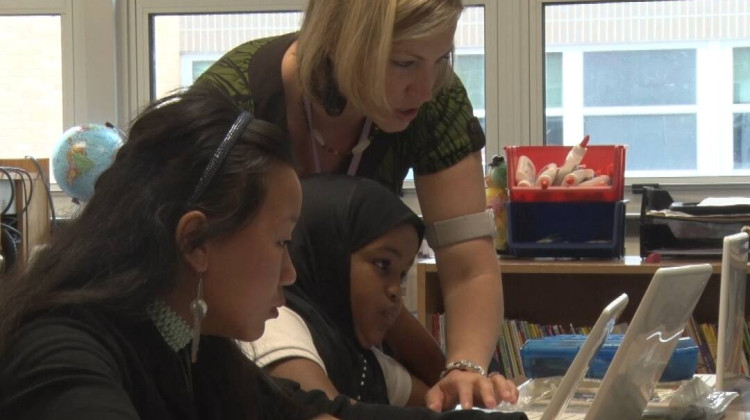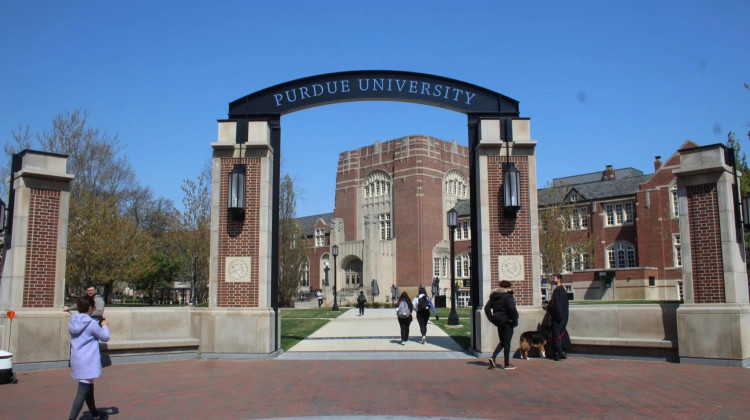
Peter Morikis, Gary Community Schools emergency manager, talks to the Distressed Unit Appeal Board on Thursday, Aug. 15, 2019 at the Government Center South Building.
Eric Weddle/WFYI NewsGary Community School Corporation's operating deficit is now $11 million, half what it once was, a financial consultant told state officials Thursday.
Eric Parish, MGT Consulting Group executive vice president, said a deficit reduction plan is on track to wipe out the annual debt in 2020 if multiple initiatives pan out.
“But we've come a long way,” Parish said. “And I think we can continue to meet those challenges -- and that's the goal. Everyone wants that sustainability because that is one of the triggers for the takeover to end.”
The five-member Distressed Unit Appeal Board voted unanimously to approve a $100,000 incentive payment to the emergency management group for paying down debts. Yet, non-voting member State Sen. J.D. Ford (D-Indianapolis) voiced concern about the payment.
“I just think the additional money should go back into the school,” he said.
Courtney Schaafsma, DUAB executive director, said the incentives are a way to hold the manager's “feet to the fire” to improve the district.
Board members, including Ford, later praised the manager's two years oversight of the district.
“You’ve turned the corner and there is light, that is impressive,” said Rep. Liz Brown (R-Fort Wayne). “But there is a long way to go.”
Gary was over spending $22 million per year in 2017 -- the year the state lawmakers made a last attempt to save the district by passing a controversial law to take it over and hire a manager to control it. A series of state loans kept the district afloat.
But the district faces more even financial challenges.
Read More: Can Gary Schools Be Saved By A State Takeover?
As of June, the district has an additional $91 million of debt from unpaid bills and other liabilities. That’s a reduction from $104 million in 2017.
Gary Schools Recovery, a group formed by MGT, won a three-year $6.2 million contract to turnaround the district’s finances and failing academics. It includes nearly $1.5 million in financial incentives for making financial and academic benchmarks
When the state takeover began, teachers lacked textbooks and curriculum guides, and some buildings were unsecured. The district also faced a massive IRS tax bill and was unable to use direct deposit to pay its hundreds of employees.
Peter Morikis, the emergency manager, says giving families new supports, from tutoring to a soon-to-launch weekend food program, is part of attracting back families. Enrollment decreased by around 800 students to 5,000 between 2016 and last school year.
Morikis said he’s not yet ready to announce enrollment numbers for 2019-20 as families continue to sign up children. Classes started Aug. 8.
“What we are trying to create is an atmosphere of pride. An atmosphere of commitment to the schools,” said Morikis, former superintendent at the neighboring Griffith Public Schools.
“We are trying to engage the community and meet their needs.”
Around 30 initiatives to cut spending and raise revenue are in various stages. The top three plans -- reducing staff, passing a local property tax levy increase and attracting “social” investors -- would push the district closer to operating in the black.
“We can not cut our way out of the situation we are in, we have to grow our way out," Parish said.
This year the district expects more than $6 million in savings from staff attrition and reduction. A voter-approved tax referendum could happen in May or November in 2020.
"If we get two of the three (initiatives), we're still in it, we’ll still land where we want to land,” Parish said of financial goals. “If we have one of the three , it's going to be a big challenge. We're gonna have to get a lot of those small wins to do better than we expect. But none of them are without their outside the realm of possibility.”
Those “small wins” include boosting enrollment, closing underused schools and energy efficiency across buildings.
Gary Schools' next financial report is expected in January.
Contact WFYI education reporter Eric Weddle at eweddle@wfyi.org or call (317) 614-0470. Follow on Twitter: @ericweddle.
 DONATE
DONATE







 Support WFYI. We can't do it without you.
Support WFYI. We can't do it without you.